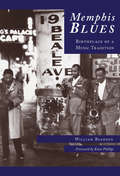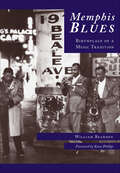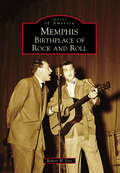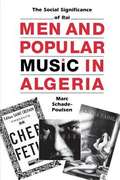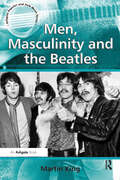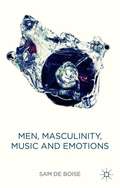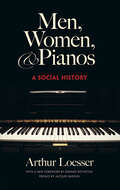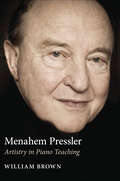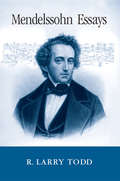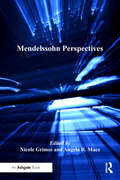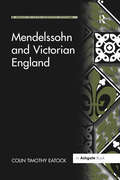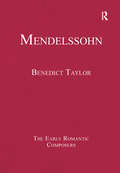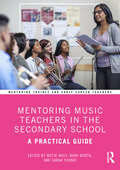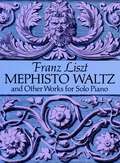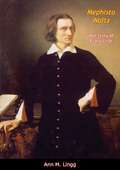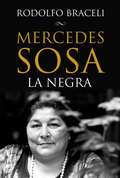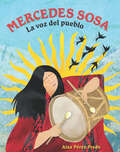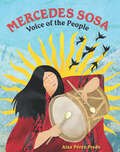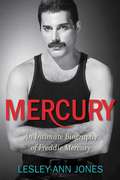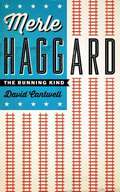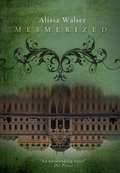- Table View
- List View
Memphis Blues: Birthplace of a Music Tradition
by William BeardenMemphis means music. That relationship was solidified in 1909 when W. C. Handy wrote the song “Mr. Crump” and later published it as the “Memphis Blues.” As Handy’s songs were sung and played in streets and music halls, a spotlight began to shine on a new mecca for innovation in music—Memphis, Tennessee. Memphis Music: Before the Blues surveys the people, music, and events that contributed to the rich musical life that emerged against the backdrop of the Civil War and yellow fever in the 19th century. The story is not just one of the building blocks to what has been called America’s greatest export—popular music—but rather it is a story of ongoing innovation and creativity that came from a convergence of people of different cultures.
Memphis Blues: Birthplace of a Music Tradition
by William BeardenThe blues was born in the Mississippi Delta, and since that fateful night in 1903 when W. C. Handy heard the mournful sound of a pocketknife sliding over the strings of an acoustic guitar and the plaintive song of a long-forgotten musician in the hot night of Tutwiler, Mississippi, the blues has been on a journey around the world. From the cotton fields and jukejoints of the Delta, up Highway 61 to Memphis�s Beale Street, St. Louis, the Southside of Chicago, England, and points beyond, the blues is America�s unique form of music. Blues is incisive in its honesty, elemental in its rhythm,and powerful in its almost visceral sensation. Nearly every style of popular music has its roots in the blues. Muddy Waters said it best: �The blues had a baby, and they called it rock and roll.� Memphis has become the heart of the blues world, with a re-born Beale Street acting as its spiritual center. People come from the world over to experience its beat, savor its emotion, and feel its power. In the end . . . �it ain�t nothin� but the blues.�
Memphis: Birthplace of Rock and Roll (Images of America)
by Robert W. DyeThe music that has been produced in Memphis over the past 100 years is as unique and diverse as the city itself. Growing out of the Mississippi Delta, the Memphis blues have been transported worldwide by such ambassadors as B.B. King and Howlin' Wolf. Rock's first baby steps were taken at the tiny Sun Studio by a group of artists who have inspired generations of musicians to follow in their beat. Soul music found its groove at Stax with a homegrown sound that exploded onto the American music scene. Music producers, including Sam Phillips, Willie Mitchell, Chips Moman, and Jim Stewart, found in Memphis a sound as distinctive as their individual personalities. Each one inspired, motivated, and encouraged their artists and, in doing so, produced a volume of work that has become the sound track of their generation.
Men and Popular Music in Algeria
by Marc Schade-PoulsenRaï music is often called the voice of the voiceless in Algeria, a society currently swept by tragic conflict. Raï is the voice of Algerian men, young men caught between generations and classes, in political strife, and in economic inequality. In a ground-breaking study, anthropologist Marc Schade-Poulsen uses this popular music genre as a lens through which he views Algerian society, particularly male society. He situates raï within Algerian family life, moral codes, and broader power relations. Schade-Poulsen did his research in the 1990s, in clubs, recording studios, at weddings, and with street musicians. He describes the history of raï, which emerged in the late 1970s and spread throughout North Africa at the same time the Islamist movement was growing to become the most potent socio-political movement in Algeria. Outsiders consider raï to be Western in origin, but Schade-Poulsen shows its Islamic roots as well. The musicians do use Western instruments, but the music itself mixes Algerian popular songs and rhythms with the beat of American disco, Egyptian modalities, Moroccan wedding tunes, and the songs of Julio Iglesias. The lyrics deal with male-female relationships but also with generational relationships and the problems of youth, as they struggle to find a place in a conflicted society. The study, in its innovative approach to music as a template of society, helps the reader understand the two major movements among today's Algerian youth: one toward the mosque and the other toward the West.
Men of Music: Their Lives, Times and Achievements
by Wallace Brockway Herbert WeinstockBiographies of Bach, Handel, von Gluck, Haydn, Mozart, Beethoven, von Weber, Rossini, Schubert, Mendelssohn, Schumann, Chopin, Berlioz, Liszt, Wagner, Verdi, Brahms, Tchaikovsky, Debussy, Strauss, Sibelius, and Stravinsky.
Men, Masculinity and the Beatles (Ashgate Popular and Folk Music Series)
by Martin KingDrawing on methodologies and approaches from media and cultural studies, sociology, social history and the study of popular music, this book outlines the development of the study of men and masculinities, and explores the role of cultural texts in bringing about social change. It is against this backdrop that The Beatles, as a cultural phenomenon, are set, and their four live action films, spanning the years 1964-1970, are examined as texts through which to read changing representations of men and masculinity in 'the Sixties'. Dr Martin King considers ideas about a male revolt predating second-wave feminism, The Beatles as inheritors of the possibilities of the 1950s and The Beatles' emergence as men of ideas: a global cultural phenomenon that transgressed boundaries and changed expectations about the role of popular artists in society. King further explores the chosen Beatle texts to examine discourses of masculinity at work within them. What emerges is the discovery of discourses around resistance, non-conformity, feminized appearance, pre-metrosexuality, the male star as object of desire, and the emergence of The Beatles themselves as a text that reflected the radical diversity of a period of rapid social change. King draws valuable conclusions about the legacy of these discourses and their impact in subsequent decades.
Men, Masculinity, Music and Emotions
by Sam BoiseThis book looks at the historic and contemporary links between music's connection to emotions and men's supposed discomfort with their own emotional experience. Looking at music tastes and distaste, it demonstrates how a sociological analysis of music and gender can actually lead us to think about emotions and gender inequalities in different ways.
Men, Women & Pianos
by Arthur LoesserSome of the greatest composers of history have confined some of their most precious thoughts to the piano. For a century and a half, series of pianists of outstanding nimbleness and expressive power have attracted millions of admirers to their performances. Mozart, Beethoven and Chopin, Liszt, Rubinstein and Rachmaninov, to achieve the fulfillment of their art, needed to have pianos. From where did they get them? From factories, of course. But piano factories cannot stay in business simply by making a few instruments for a few great musicians. They must sell their products annually by the hundreds, by the thousands, to all manner of persons: doctors, lawyers, merchants, government officials. What did those persons want with pianos? This book may supply some answers to this question." That is the modest raison d'être for his book given by the author in a letter to the publisher. But any reader will see at once that the proliferations in the answer to his question result in something much more important and delightful. What Mr. Loesser has written is really a piano's-eye view of the social--and sometimes the philosophical--history of Western Europe and the United States from the seventeenth century to the present, with glances both forward and back. With a keen eye for both the ridiculous and the significant detail (which turn out often to be the same thing), he traces the history of the design and manufacture of the piano, and the music written for it, from its predecessors, the clavichord and the virginal, to the latest concert grand and the modern "spinet." Long established as an internationally known concert pianist, Mr. Loesser here shows himself to be an elegant stylist and an impressively learned scholar, who has the wit to see that in a social history the role of the interior decorator may be quite as important as that of the virtuoso--and that of the ambitious parent, more important than either.
Men, Women and Pianos: A Social History
by Arthur LoesserA piano's-eye view of the social and philosophical history of Western Europe and the United States from the 17th century to the 1950s, with glances forward and back.
Men, Women and Pianos: A Social History
by Arthur LoesserAs the "social anchor" in middle-class homes of the nineteenth century, the piano was simultaneously an elegant piece of drawing-room furniture, a sign of bourgeois prosperity, and a means of introducing the young to music. In this admirably balanced and leisurely account of the popular instrument, the late, internationally known concert pianist Arthur Loesser takes a "piano's-eye view" of the recent social history of Western Europe and the United States.Drawing on newspapers, music manuscripts, popular accounts, and other sources, Loesser traces the history of the piano from its predecessors, the clavichord and the harpsichord, to the modern spinet and concert grand. Chapter headings such as "Clavichords Make Weeping Easier," "The Harpsichord Grows Feet," "The More Pianos the Merrier," and "The Keyboards Go West" suggest the author's lighthearted approach to topics ranging from the piano's European origins and its introduction in the United States to the decline of piano manufacturing in the early twentieth century and the "victory of airborne music" by mid-century. A preface by historian Jacques Barzun and a new foreword by music critic Edward Rothstein enhance a volume rich in wit and knowledge -- one that will delight any reader with an interest in the piano and on Western cultural history.
Menahem Pressler: Artistry in Piano Teaching
by William BrownAs soloist, master class teacher, and pianist of the world-renowned Beaux Arts Trio, Menahem Pressler can boast of four Grammy nominations, three honorary doctorates, more than 80 recordings, and lifetime achievement awards presented by France, Germany, and Israel. Former Pressler student William Brown traces the master's pianistic development through Rudiakov, Kestenberg, Vengerova, Casadesus, Petri, and Steuermann, blending techniques and traditions derived from Beethoven, Chopin, Liszt, and J. S. Bach. Brown presents Pressler's approach to performance and teaching, including technical exercises, principles of relaxation and total body involvement, and images to guide the pianist's creativity toward expressive interpretation. Insights from the author's own lessons, interviews with Pressler, and recollections of more than 100 Pressler students from the past 50 years are gathered in this text. Measure-by-measure lessons on 23 piano masterworks by, among others, Bach, Bartók, Debussy, and Ravel as well as transcriptions of Pressler's fingerings, hand redistributions, practicing guidelines, musical scores, and master class performances are included.
Mendelssohn Essays: Essays On Their Music And Its Context
by R. Larry ToddWhen R. Larry Todd’s biography, Mendelssohn: A Life in Music, appeared in 2003, it won acclaim from several critics as a definitive biography. In researching Mendelssohn’s life over the last two and a half decades, Todd uncovered much new information about the composer and his music, his family and his peers, and his complex reception history. Now, as we approach the 2009 bicentenary of Mendelssohn’s birth, the author has chosen and compiled fifteen essays written between 1980 and 2005, including five previously unpublished, that examine several aspects of the composer whom Goethe and Heine likened to a second Mozart. Mendelssohn Essays explores Mendelssohn’s precocity, his musical impressions of British culture, the role of the visual in his music, his compositional response to Bach’s St. Matthew Passion, and incomplete drafts from his musical estate of three instrumental works. In addition, a group of three essays focuses on the music of Mendelssohn’s sister Fanny Hensel, perhaps the most gifted woman composer of the century, and a significant, complex figure in the formation of the Mendelssohnian style.
Mendelssohn Perspectives
by Nicole Grimes Angela R. MaceIf the invective of Nietzsche and Shaw is to be taken as an endorsement of the lasting quality of an artist, then Felix Mendelssohn Bartholdy takes pride of place beside Tennyson and Brahms in the canon of great nineteenth-century artists. Mendelssohn Perspectives presents valuable new insights into Mendelssohn’s music, biography and reception. Critically engaging a wide range of source materials, the volume combines traditional musical-analytical studies with those that draw on other humanistic disciplines to shed new light on the composer’s life, and on his contemporary and posthumous reputations. Together, these essays bring new historical and interpretive dimensions to Mendelssohn studies. The volume offers essays on Mendelssohn's Jewishness, his vast correspondence, his music for the stage, and his relationship with music of the past and future, as well as the compositional process and handling of form in the music of both Mendelssohn and his sister, the composer Fanny Hensel. German literature and aesthetics, gender and race, philosophy and science, and issues of historicism all come to bear on these new perspectives on Mendelssohn.
Mendelssohn and Victorian England (Music In Nineteenth-century Britain Ser.)
by ColinTimothy EatockThis valuable book considers the reception of the composer, pianist, organist and conductor Felix Mendelssohn in nineteenth-century England, and his influence on English musical culture. Despite the composer's immense popularity in the nation during his lifetime and in the decades following his death, this is the first book to deal exclusively with the subject of Mendelssohn in England. Mendelssohn's highly successful ten trips to Britain, between 1829 and 1847, are documented and discussed in detail, as are his relationships with English musicians and a variety of prominent figures. An introductory chapter describes the musical life of England (especially London) at the time of Mendelssohn's arrival and the last two chapters deal with the composer's posthumous reception, to the end of the Victorian era. Eatock reveals Mendelssohn as a catalyst for the expansion of English musical culture in the nineteenth century. In taking this position, the author challenges much of the extant literature on the subject and provides an engaging story that brings Mendelssohn and his English experiences to life.
Mendelssohn, Time and Memory
by Benedict TaylorFelix Mendelssohn has long been viewed as one of the most historically minded composers in western music. This book explores the conceptions of time, memory and history found in his instrumental compositions, presenting an intriguing new perspective on his ever-popular music. Focusing on Mendelssohn's innovative development of cyclic form, Taylor investigates how the composer was influenced by the aesthetic and philosophical movements of the period. This is of key importance not only for reconsideration of Mendelssohn's work and its position in nineteenth-century culture, but also more generally concerning the relationship between music, time and subjectivity. One of very few detailed accounts of Mendelssohn's music, the study presents a new and provocative reading of the meaning of the composer's work by connecting it to wider cultural and philosophical ideas.
Mendelssohn: The Romantic Conception Of Cyclic Form
by Benedict TaylorThis volume of essays brings together a selection of the most significant and representative writings on Mendelssohn from the last fifty years. Divided into four main subject areas, it makes available twenty-two essays which have transformed scholarly awareness of this crucial and ever-popular nineteenth-century composer and musician; it also includes a specially commissioned introductory chapter which offers a critical overview of the last half century of Mendelssohn scholarship and the direction of future research. The addition of new translations of two influential essays by Carl Dahlhaus, hitherto unavailable in English, adds to the value of this volume which brings back in to circulation important scholarly works and constitutes an indispensable reference work for Mendelssohn scholars.
Mentoring Music Teachers in the Secondary School: A Practical Guide (Mentoring Trainee and Early Career Teachers)
by Sarah Younie Nikki Booth Motje WolfMentoring Music Teachers in the Secondary School helps mentors of trainee and newly qualified music teachers in both developing their own mentoring skills and providing the essential guidance their beginning teachers need as they navigate the roller-coaster of the first years of teaching. Offering tried and tested strategies based on research and evidence, this book covers the knowledge, skills, understanding, and practical tools every mentor needs.This book is a vital source of support and inspiration for mentors involved in developing the next generation of outstanding music education teachers. Key topics explained include: What is meant by mentoring What a mentor does Supporting specific aspects of beginning music teachers’ knowledge, skills, and understanding Moving beginning music teachers on in their professional practice Filled with key tools for the mentor’s individual development, this essential text offers an accessible guide to mentoring early career music education teachers with ready-to-use strategies that support and inspire both mentors and beginning teachers alike.
Mephisto Waltz and Other Works for Solo Piano (Dover Classical Piano Music)
by Franz LisztA prolific composer and virtuoso pianist, Franz Liszt (1811-1886) was the most lionized musical personality of his time. His compositions for solo piano continue to be loved and admired by pianists and their audiences for their lush Romanticism and technical fireworks. They remain among the most frequently performed works in the repertoire. This choice selection of Liszt piano works reveals the powers at this extraordinary composer's command: Mephisto Waltz No.1; Nuages Gris; Liebesträume Nos. 1, 2 & 3; Grand Galop Chromatique; Polonaises Nos. 1 & 2; Valse-Impromptu in A-flat Major; Fantasia and Fugue on the Theme BACH; La Lugubre Gondola I & II; Valse Oubliée No. 1; Czárdás Macabre; Gretchen (from A Faust Symphony); Unstern: Sinsitre, Disastro; and Rhapsodie Espagnole.
Mephisto Waltz: The Story of Franz Liszt
by Ann M. LinggBeethoven, Brahms, Schumann, Berlioz, Rossini, Wagner, Meyerbeer, Mendelssohn, Chopin, Rubinstein. These musical greats were Franz Liszt’s contemporaries and friends during his long, tempestuous, and productive life—a life lived during one of the richest periods in all musical history.Born in Austria-Hungary, Liszt learned to play the piano at an early age; he was then taken to Vienna to study under the great teacher, Czerny, Beethoven’s own pupil. Before he was fourteen, Liszt played concerts and recitals in Paris and London. Whilst still on the threshold of his fabulous career, Liszt felt dissatisfaction with his worldly life and seriously considered entering the priesthood. But this man, a failure when he lived a conventional life and successful only when wildly extravagant, became instead the leader in the fashionable musical world of Pairs—and eventually of all Europe. It was only in old age that he returned to the spiritual and became the Abbé Liszt.
Mercedes Sosa, La Negra (Edición definitiva)
by Rodolfo BraceliLa negra Mercedes Sosa canta su biografía. A los 67, en el 2003, decidiócontar su vida. Como no quiso simularse escritora, la suya es unabiografía en voz alta. «Mercedes Sosa. La Negra» es la edición definitiva de la única biografíaque se realizó con su palabra viva. Es así como, para un personajecomplejo y atípico, Rodolfo Braceli eligió un camino inusual. Todo subagaje de escritor, periodista, dramaturgo y poeta lo despliega en esteoriginal libro desde y sobre Mercedes Sosa. Por un lado, el relato de lasuprema cantante-cantora es la columna vertebral. Por otro, emergenvoces: la de su madre y hermanos, la de su hijo y amigos.Cada tanto aparecen, con sus recuerdos, figuras como León Gieco, HoracioMolina, Víctor Heredia, Liliana Herrero, Carlos Alonso y Charly García.Ellos completan el retrato de la otra Mercedes, la que estaba lejos delas ovaciones y muy cerca de la gente.No es todo: a la voz, por momentos en carne viva de la protagonista, sesuma en el montaje el relato de episodios dramáticos y memorables quemarcaron su vida y su carrera. Este libro que empezó a gestarse hacecasi medio siglo incluye infancia, adolescencia, despertar artístico,amores y desamores, ideología, amenazas de muerte, censura y exilio,glorioso retorno en el 82, consagración mundial, enfermedad conapetencia de suicidio en el 97, testamento. Como escribió LilianaHerrero: «Estamos ante una confesión pasional, pero también ante undocumento extraordinario. Ante un libro político y también profundamenteíntimo, público y privado, indispensable para contar la historiacultural de este país».
Mercedes Sosa: La voz del pueblo
by Aixa Pérez-PradoUna conmovedora biografía ilustrada de una de las cantantes y defensoras de derechos humanos más queridas de América Latina, Mercedes Sosa. A stirring picture book biography of one of Latin America's most beloved singers and human rights advocates, Mercedes Sosa.¿Alguna vez has oído una canción que te elevó a lo más alto? ¿Una canción que capturó tu corazón? ¿Una voz tan poderosa que te hizo sentir listo para cambiar el mundo? Esta es la historia de una cantora cuya voz navegó por el aire como las alas de un cóndor, inspirando al pueblo en cada latido de la tierra. Escrita e ilustrada por Aixa Pérez-Prado, esta es la conmovedora historia de la cantante folklórica y defensora de derechos humanos argentina Mercedes Sosa. Conocida cariñosamente como la Negra, Mercedes utilizó su talento musical y su poderosa voz para denunciar la pobreza y la desigualdad en su país. Ante una cruel dictadura, Mercedes se negó a ser silenciada. Con valentía subió al escenario para "dar voz a los que no tienen voz" con canciones edificantes de empatía y empoderamiento. Su música inolvidable y sus mensajes de esperanza continúan resonando en personas de todo el mundo hasta el día de hoy. Written and illustrated by Aixa Pérez-Prado, this is the powerful biography of Argentinean folksinger and human rights advocate Mercedes Sosa. Affectionately known as La Negra, Mercedes used her musical talents and powerful voice to speak out against poverty and inequality in her home country. In the face of a cruel dictatorship, Mercedes refused to be silenced. She bravely stepped on stage to lend a "voice to the voiceless" with uplifting songs of empathy and empowerment. Her unforgettable music and messages of hope continue to resonate with people across the world to this day.
Mercedes Sosa: Voice of the People
by Aixa Pérez-PradoA stirring picture book biography of one of Latin America's most beloved singers and human rights advocates, Mercedes Sosa.Have you ever heard a song that made your heart soar? A canción that captured your corazón? A voice so powerful that it made you feel ready to change the world? This is the story of a singer whose voice sailed through the air like the wings of a condor, inspiring people everywhere. Written and illustrated by Aixa Pérez-Prado, this is the powerful biography of Argentinean folksinger and human rights advocate Mercedes Sosa. Affectionately known as La Negra, Mercedes used her musical talents and powerful voice to speak out against poverty and inequality in her home country. In the face of a cruel dictatorship, Mercedes refused to be silenced. She bravely stepped on stage to lend a "voice to the voiceless" with uplifting songs of empathy and empowerment. Her unforgettable music and messages of hope continue to resonate with people across the world to this day.
Mercury: An Intimate Biography of Freddie Mercury
by Lesley-Ann JonesA REVEALING, INTIMATE LOOK AT THE MAN WHO WOULD BE QUEEN As lead vocalist for the iconic rock band Queen, Freddie Mercury's unmatched skills as a songwriter and his flamboyant showmanship made him a superstar and Queen a household name. But despite his worldwide fame, few people ever really glimpsed the man behind the glittering façade. Now, more than twenty years after his death, those closest to Mercury are finally opening up about this pivotal figure in rock 'n' roll. Based on more than a hundred interviews with key figures in his life, Mercury offers the definitive account of one man's legendary life in the spotlight and behind the scenes. Rock journalist Lesley-Ann Jones gained unprecedented access to Mercury's tribe, and she details Queen's slow but steady rise to fame and Mercury's descent into dangerous, pleasure-seeking excesses-- this was, after all, a man who once declared, "Darling, I'm doing everything with everyone." In her journey to understand Mercury, Jones traveled to London, Zanzibar, and India--talking with everyone from Mercury's closest friends to the sound engineer at Band Aid (who was responsible for making Queen even louder than the other bands) to second cousins halfway around the world. In the process, an intimate and complicated portrait emerges. Meticulously researched, sympathetic yet not sensational, Mercury offers an unvarnished look at the extreme highs and lows of life in the fast lane. At the heart of this story is a man . . . and the music he loved.
Merle Haggard: The Running Kind
by David CantwellMerle Haggard has enjoyed artistic and professional triumphs few can match. He's charted more than a hundred country hits, including thirty-eight number ones. He's released dozens of studio albums and another half dozen or more live ones, performed upwards of ten thousand concerts, been inducted into the Country Music Hall of Fame, and seen his songs performed by artists as diverse as Lynryd Skynyrd, Elvis Costello, Tammy Wynette, Willie Nelson, the Grateful Dead, and Bob Dylan. In 2011 he was feted as a Kennedy Center Honoree. But until now, no one has taken an in-depth look at his career and body of work. In Merle Haggard: The Running Kind, David Cantwell takes us on a revelatory journey through Haggard's music and the life and times out of which it came. Covering the entire breadth of his career, Cantwell focuses especially on the 1960s and 1970s, when Haggard created some of his best-known and most influential music, which helped invent the America we live in today. Listening closely to a masterpiece-crowded catalogue (including songs such as "Okie from Muskogee," "Sing Me Back Home," "Mama Tried," "Working Man Blues," "Kern River," "White Line Fever," "Today I Started Loving You Again," and "If We Make It through December," among many more), Cantwell explores the fascinating contradictions-most of all, the desire for freedom in the face of limits set by the world or self-imposed-that define not only Haggard's music and public persona but the very heart of American culture.
Mesmerized
by Alissa WalserMozart's Vienna. A crucible for scientific experimentation and courtly intrigue, as Europe's finest minds vie for imperial favour. In a colourful, chaotic private hospital that echoes with the shrieks of hysterical patients, Franz Anton Mesmer is developing a series of controversial cure-alls for body and mind. When he is asked to help restore the sight of a blind musical prodigy favoured by the Empress herself, he senses that fame, and even immortality, is within his grasp. Mesmer knows that he will have to gain her trust if he is to open her eyes. But at what cost to her fragile talent? And will their intimacy result in scandal?
